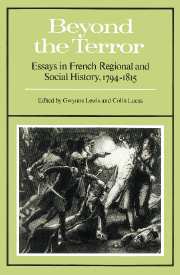Book contents
- Frontmatter
- Contents
- Contributors
- Preface
- 1 Cobb and the historians
- 2 The reconstruction of a church 1796–1801
- 3 Picking up the pieces: the politics and the personnel of social welfare from the Convention to the Consulate
- 4 Conscription and crime in rural France during the Directory and Consulate
- 5 Common rights and agrarian individualism in the southern Massif Central 1750–1880
- 6 Themes in southern violence after 9 thermidor
- 7 Political brigandage and popular disaffection in the south-east of France 1795–1804
- 8 Rhine and Loire: Napoleonic elites and social order
- Index
7 - Political brigandage and popular disaffection in the south-east of France 1795–1804
Published online by Cambridge University Press: 04 November 2009
- Frontmatter
- Contents
- Contributors
- Preface
- 1 Cobb and the historians
- 2 The reconstruction of a church 1796–1801
- 3 Picking up the pieces: the politics and the personnel of social welfare from the Convention to the Consulate
- 4 Conscription and crime in rural France during the Directory and Consulate
- 5 Common rights and agrarian individualism in the southern Massif Central 1750–1880
- 6 Themes in southern violence after 9 thermidor
- 7 Political brigandage and popular disaffection in the south-east of France 1795–1804
- 8 Rhine and Loire: Napoleonic elites and social order
- Index
Summary
On 1 March 1801, the Abbé Solier was executed in Le Vigan (Gard) for ‘crimes committed against the Republic’. Solier, one of the most notorious ‘political brigands’ operating in the south of France during the period of the Directory, had commanded his bande d'égorgeurs, based along the borders of the departments of the Gard, the Hérault and the Ardèche, from 1795 to his death in 1801. He is by no means one of the forgotten heroes of catholic royalist resistance against the Revolution. The protestant writer, André Chamson, chose Solier as the hero of his latest ‘roman dans l'Histoire’. Philippe Senart has recently devoted two articles in the Revue des deux-mondes to an appreciation of Solier's contribution to the cause of catholic royalism, confronted in the Cévennes region by a powerful tradition of protestant republicanism. Senart notes how, through the medium of the veillées, his grandmother would transmit accounts of the good abbé giving the first communion to catholic children in remote caves and woods; celebrating mass secretly during the worst bouts of persecution; dying a martyr for le bon roi et les bons prêtres. Through the works of Chamson and Senart, we are conducted along the tortuous paths of Cévenol folklore where les étrangers, then as now, are well advised to tread cautiously.
However, it was not only in the Cévennes – la terre sainte of protestantism – that the égorgeurs of the south-east operated. Radiating outwards from traditional areas of revolt and particularism, catholic royalist brigandage was to affect many regions within the former provinces of Languedoc and Provence.
- Type
- Chapter
- Information
- Beyond the TerrorEssays in French Regional and Social History 1794-1815, pp. 195 - 231Publisher: Cambridge University PressPrint publication year: 1983
- 4
- Cited by

